
  

























 |
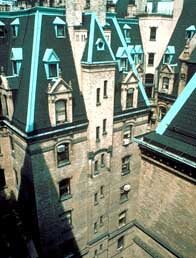
Slate and copper mansard roofs in an urban canyon. |
The
roof--with its shape; features such as cresting, dormers, cupolas,
and chimneys; and the size, color, and patterning of the roofing
material--is an important design element of many historic buildings.
In addition a weathertight roof is essential to the longterm preservation
of the entire structure. Historic roofing reflects availability
of materials, levels of construction technology, weather, and cost.
For example, throughout the country in all periods of history,
wood shingles have been used--their size, shape, and detailing
differing according to regional craft practices. European settlers
used clay tile for roofing as early as the mid-17th century.
In some cities, such as New York and Boston, clay was popularly
used as a precaution against fire. The Spanish influence in the
use of clay tile is found in the southern, southwestern and western
states. In the mid-19th century, tile roofs were often replaced
by sheet metal, which is lighter and easier to maintain.
Evidence of the use of slate for roofing dates from the mid-17th
century. Slate has remained popular for its durability, fireproof
qualities, and its decorative applications. The use of metals for
roofing and roof features dates from the 18th century, and includes
the use of sheet iron, corrugated iron, galvanized metal,
tin-plate, copper, lead and zinc. Awareness of these and other
traditions of roofing materials and their detailing will contribute
to more sensitive treatment.
|
|
Roofs
|
....Identify,
retain, and preserve
|
 |
|
recommended.....
|

|
| |
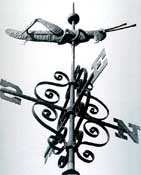
Copper and wrought iron weathervane. |
Identifying,
retaining, and preserving roofs--and their functional and decorative
features--that are important in defining the overall historic character
of the building. This includes the roof's shape, such as hipped,
gambrel, and mansard; decorative features, such as cupolas, cresting
chimneys, and weathervanes; and roofing material such as slate,
wood, clay tile, and metal, as well as its size, color, and patterning.
|
|
not
recommended.....
|

|
| |
Radically
changing, damaging, or destroying roofs which are important in defining
the overall historic character of the building so that, as a result,
the character is diminished.
Removing
a major portion of the roof or roofing material that is repairable,
then reconstructing it with new material in order to create a uniform,
or "improved" appearance.
Changing
the configuration of a roof by adding new features such as dormer
windows, vents, or skylights so that the historic character is diminished.
Stripping
the roof of sound historic material such as slate, clay tile, wood,
and architectural metal.
Applying
paint or other coatings to roofing material which has been historically
uncoated.
|
|
Roofs
|
....Protect
and Maintain
|
 |
|
recommended.....
|

|
| |
Protecting
and maintaining a roof by cleaning the gutters and downspouts and
replacing deteriorated flashing.

Gable and pent roof in excellent condition. |
Roof sheathing should also be checked
for proper venting to prevent moisture condensation and water penetration;
and to insure that materials are free from insect infestation.
Providing
adequate anchorage for roofing material to guard against wind damage
and moisture penetration.
Protecting
a leaking roof with plywood and building paper until it can be properly
repaired.
|
|
not
recommended.....
|

|
| |
Failing
to clean and maintain gutters and downspouts properly so that water
and debris collect and cause damage to roof fasteners, sheathing,
and the underlying structure.
Allowing
roof fasteners, such as nails and clips to corrode so that roofing
material is subject to accelerated deterioration.
Permitting
a leaking roof to remain unprotected so that accelerated deterioration
of historic building materials--masonry, wood, plaster, paint and
structural members--occurs.
|
|
Roofs
|
....Repair
|
 |
|
recommended.....
|

|
| |
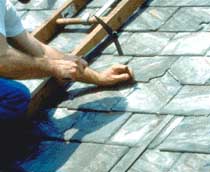
Repairing slate roof using traditional methods. |
Repairing
a roof by reinforcing the historic materials which comprise roof
features. Repairs will also generally include the limited replacement
in kind--or with compatible substitute material--of those extensively
deteriorated or missing parts of features when there are surviving
prototypes such as cupola louvers, dentils, dormer roofing; or slates,
tiles, or wood shingles on a main roof.
|
|
not
recommended.....
|

|
| |
Replacing
an entire roof feature such as a cupola or dormer when repair of
the historic materials and limited replacement of deteriorated or
missing parts are appropriate.
Failing
to reuse intact slate or tile when only the roofing substrate needs
replacement.
Using
a substitute material for the replacement part that does not convey
the visual appearance of the surviving parts of the roof or that
is physically or chemically incompatible.
|
|
Roofs
|
....Replace
|
 |
|
recommended.....
|

|
| |
Replacing
in kind an entire feature of the roof that is too deteriorated to
repair--if the overall form and detailing are still evident--using
the physical evidence as a model to reproduce the feature.
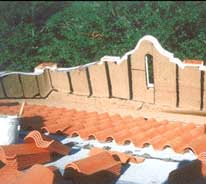
Replacement of damaged clay tile roof. |
Examples
can include a large section of roofing, or a dormer or chimney.
If using the same kind of material is not technically or economically
feasible, then a compatible substitute material may be considered.
|
|
not
recommended.....
|

|
| |
Removing
a feature of the roof that is unrepairable, such as a chimney or
dormer, and not replacing it; or replacing it with a new feature
that does not convey the same visual appearance
|
| |
Design
for Missing Historic Features
The
following work is highlighted to indicate that it represents the
particularly complex technical or design aspects of rehabilitation
projects and should only be considered after the preservation concerns
listed above have been addressed.
|
|
recommended.....
|

|
| |
Designing
and constructing a new feature when the historic feature is completely
missing, such as a chimney or cupola. It may be an accurate restoration
using historical, pictorial, and physical documentation; or be a
new design that is compatible with the size, scale, material, and
color of the historic building.
|
|
not
recommended.....
|

|
| |
Creating
a false historical appearance because the replaced feature is based
on insufficient historical, pictorial, and physical documentation.
Introducing
a new roof feature that is incompatible in size, scale, material
and color.
|
| |
Alterations/Additions
for the New Use
The
following work is highlighted to indicate that it represents the
particularly complex technical or design aspects of rehabilitation
projects and should only be considered after the preservation concerns
listed above have been addressed.
|
|
recommended.....
|

|
| |
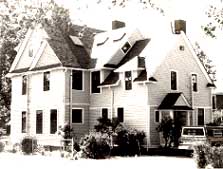
Non-obtrusive skylights on rear of residence. |
Installing
mechanical and service equipment on the roof, such as air conditioning,
transformers, or solar collectors when required for the new use
so that they are inconspicuous from the public right-of-way and
do not damage or obscure character-defining features.
Designing
additions to roofs such as residential, office, or storage spaces;
elevator housing; decks and terraces; or dormers or skylights when
required by the new use so that they are inconspicuous from the
public right-of-way and do not damage or obscure character-defining
features.
|
|
not
recommended.....
|

|
| |
Installing
mechanical or service equipment so that it damages or obscures character-defining
features; or is conspicuous from the public right-of-way.
Radically
changing a character-defining roof shape or damaging or destroying
character-defining roofing material as a result of incompatible
design or improper installation techniques.
|
|

